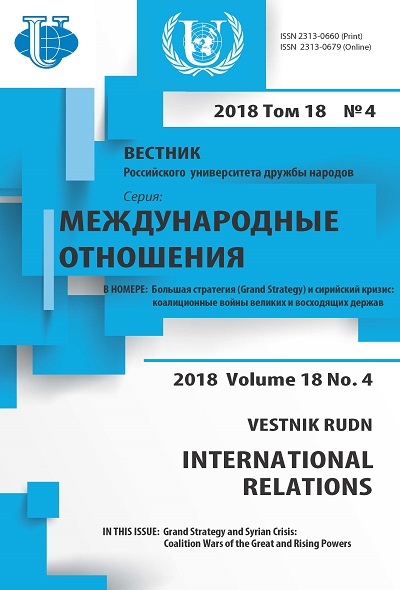Iran’s Contemporary Anti-Terrorism Approach: “Hard” and “Soft” Elements
- Authors: Jabbari Nasir H.1, Bahriev B.K.1
-
Affiliations:
- Moscow State Institute of International Relations (MGIMO University)
- Issue: Vol 18, No 4 (2018): Grand Strategy and Syrian Crisis: Coalition Wars of the Great and Rising Powers
- Pages: 823-836
- Section: THEMATIC DOSSIER
- URL: https://journals.rudn.ru/international-relations/article/view/20326
- DOI: https://doi.org/10.22363/2313-0660-2018-18-4-823-836
Cite item
Full Text
Abstract
The article deals with “hard” and “soft” elements of Iran’s contemporary anti-terrorism approach. The authors state that fighting against terrorism today demands a comprehensive approach, and though force-based approach has always prevailed over “soft” tools in realization of anti-terrorist strategies of states, in modern world realities without a psycho-ideological component combating terrorism does not seem to succeed. A balanced universal model of using these two components does not exist, as everything in this context depends on specifics of a country or a region. But the need for considering “soft” aspects becomes more relevant. Iran is an active player in combating international terrorism, though it does not have a unified document or specific strategy with defined “hard” and “soft” tools of anti-terrorism fight. The force-based element of Iran’s counter-terrorism approach at the present stage obviously prevails over the non-powerbased. The country’s active military involvement in solution of the Syrian crisis, supporting military groups, which fight against radical element in the region and tough policy towards drug traffic is an important source of income for extremist factions, proves the matter. “Hard power” approach in fighting against terrorism leads to physical extermination of terrorists, however, consideration of the survival of their ideas in modern info-communications century reveals the significance of the issue of “soft” instrument use in anti-terrorism strategy. In fight against terrorism in this dimension, Iran resorts to “soft power” and public diplomacy. The cultural, religious and scientific potentials as well as educational institutes and information resources are actively utilized to construct a correct understanding of Islam and its positive image, to delegitimate and deconstruct narratives of radical Islamists.
About the authors
Hasan Jabbari Nasir
Moscow State Institute of International Relations (MGIMO University)
Author for correspondence.
Email: hjabbarinasir@gmail.com
PhD in Political Science, Member of the Institute of Cultural and Social Studies of IRI
Bahri Khurshedovich Bahriev
Moscow State Institute of International Relations (MGIMO University)
Email: mr.bahriev29@gmail.com
PhD student, World Politics Department, MGIMO University
References
- Bakhriev, B.Kh. & Jabbari Nasir, H. (2017). Public diplomacy in the foreign policy of the Islamic Republic of Iran. In: Public Diplomacy: Theory and Pracrice. Ed. by M.M. Lebedeva. Moscow: Aspekt Press. P. 194—216. (in Russian).
- Chikrizova, O.S. (2017). “Oppressed — oppressors” Dichotomy in Shiʻite Perception of International Relations. Vestnik RUDN. International Relations, 17(2), 279—289. doi: 10.22363/2313-0660-2017-17-2-279-289. (in Russian).
- Druzhilovskij, S.B. (2017). Transformation of Iran’s Foreign Policy. Observer, 3, 25—35. (in Russian).
- Filin, N.A. & Piloyan, M.G. (2015). Ayatollah Ali Sistani: New Opportunities of the Old School of the Shiite Religious Mentoring. Vlast’, 2, 133—137. (in Russian).
- Hajiyusefi, A. & Bageri, A. (2011). Issues of Developing a National Security Strategy for Iran. Daneshe siyasi, 2, 69—97. (in Persian).
- Jabbari Nasir, H. (2016). Iran’s Potential in Fighting International Terrorism. Vestnik RUDN. International Relations, 16(4), 665—676. (in Russian).
- Jabbari Nasir, H. (2017). Islamic Institutions Approach toward Combating International Terrorism. Comparative politics, Russia, 8(4), 42—59. doi: 10.18611/2221-3279-2017-8-4-42-59. (in Russian).
- Kurylev, K.P., Nikulin, M.A. & Goncharova, A.A. (2017). The “Soft power” of Cultural Diplomacy of the Islamic Republic of Iran. Vestnik MGOU. History and Political Science, 2, 46—55. doi: 10.18384/2310-676X-2017-2-46-55. (in Russian).
- Leonard, М., Stead, С. & Smewing, С. (2002). Public Diplomacy. London: The Foreign Policy Centre.
- Leonova, O.G. (2014). “Soft power”: Tools and Influence Coefficients. Observer, 3, 18—28. (in Russian).
- Malekzadeh, M. (2015). “Soft power” of Iran in a Regional Context. Siyasate motaolie, 11, 133—154. (in Persian).
- Nikravish, M. & Dja’fari, A.A. (2016). Role of Marjaye Taqlid and Iraqi Theologians in Enhancing the “Soft Power” of Iran. Motaleate siyasie jahane islam, 18, 105—138. (in Persian).
- Nye, J. (2004). Soft Power and the Struggle Against Terrorism. Project Syndicate, Apr. 24. URL: https://www.project-syndicate.org/commentary/soft-power-and-the-struggle-against-terrorism (accessed: 05.09.2018).
- Nye, J. (2008). Public Diplomacy and Soft Power. Annals of the American Academy of Political and Social Science, 616(1), 94—109. doi: 10.1177/0002716207311699.
- Pahlavi, P. (2012). Understanding Iran’s Media Diplomacy. Israel Journal of Foreign Affairs, 6(2), 21—33.
- Sahraian, M. (2011). Iran Money Laundering Survey. Majles ve rahbord, 37, 337—368. (in Persian).
- Torfeh, M. (2017). The Role of Iran’s Regional Media in its Soft War Policy. Al Jazeera Centre for Studies. February 16. URL: http://studies.aljazeera.net/mritems/Documents/2017/4/9/ de4a4f02558e40a9ada8948554fec007_100.pdf (accessed: 21.09.2018).
- Tsvetkova, N.A. (2017). USA — ISIS: Information Confrontation. Asia and Africa Today, 2, 2—7. (in Russian).
- Veselovskij, S.S. (2010). Goals and Ideological Rationale of Global Terrorism. Vestnik MGIMO University, 6, 152—159. (in Russian).
- Yurtaev, V.I. (2018). Islamization as a Factor of Iranian Foreign Policy. Moscow: Aspekt Press publ. (in Russian).











